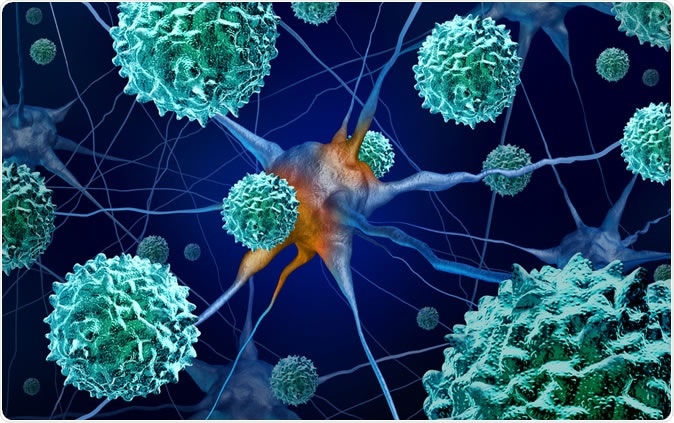The Centers for Disease Control and Prevention (CDC) has warned that a series of rare and difficult to treat cases of paralysis are being seen in otherwise healthy children since 2018. This outbreak is 2018 may soon make a comeback in 2020 the organization warns doctors and paediatricians. The report was published in the CDC’s Vital Signs this week.
The experts have called this acute flaccid myelitis or AFM that is typically manifested as a sudden onset of weakness especially of the upper limbs followed by paralysis and lesions in and around the spinal cord as detected by MRI scans. The cause of this paralysis is unknown and is commonly seen in children.

AFM disease or acute flaccid myelitis as a 3D illustration. Credit: Lightspring / Shutterstock
Researchers believe that the paralysis which is similar to AFP (acute flaccid paralysis) seen with polio virus infections could be caused by a relative of the same virus.
At present the disease remains incurable and difficult to treat. For most patients the paralysis is self-limiting and often goes away on its own and many regain their muscle strength and recover the complete use of their paralyzed limbs with time. In some however the paralysis may remain constant and residual weakness may continue. In a small fraction, the paralysis may affect the respiratory muscles and lead to respiratory failure and even death, explain the researchers.
This form of AFM first was detected in 2014 when there was a rise in number of cases of polio like paralysis among children. The pattern of the outbreaks seemed to occur every other year says the CDC. For example in 2014 there were 120 cases recorded from 34 states and only 22 in 2015. Again in 2016 there were 149 cases from 39 states and Washington, DC followed by a drop to 35 cases in 2017. A significant 233 cases were recorded in 2018 from 41 states says the CDC and this year may be a lull period. In 2019 there have been 11 reported cases so far. The peak period of this illness however in between August and November says the CDC and thus a few more may be added to the records. Next year 2020 may show the next surge in cases says the CDC.
The CDC officials warn that in 2018, 60 percent of the patients needed intensive care treatment and 27 percent needed respiratory support. Most of these patients were around 5 years of age says the CDC.
The experts have warned that there has been a coincidence of national outbreak of Enterovirus D68 or EV-D68 in 2014 around the time of AFM cases outbreak. The EV-D68 is also known to cause a respiratory infection.
Experts and epidemiologists are seeing a connection between the paralysis cases and the EV-D68 infections. They explain that poliovirus is also an enterovirus and enterovirus type EV-A71 has been linked to hand-foot-and-mouth disease that could lead to polio like features. The spinal lesions seen in patients of AFM in 2014 were consistent with the EV-D68 infections and damage inflicted by the virus the experts have reported. Both poliovirus and EV-A71 are known to cause infections such as these they add. Further the epidemiologists have noted that the peak seasons for Enterovirus infections coincide with the AFM outbreak seasons as well. This further connects the two incidences. The case histories of the patients of the infection reveals that before onset of the paralysis, they had a minor respiratory infection or fever after which there was a sudden onset of the limb weaknesses. In 2018 for example the weakness followed an average of five days after the mild viral fever or infection. The CDC and other experts say that this could be the circumstantial evidence needed to pick out the culprit virus for the AFM cases.
However the evidence remains only circumstantial at best. From the 233 cases that were recorded in 2018, only 123 samples of respiratory exudates could be collected. Of these again only 30 were confirmed cases of EV-D68 and 10 were positive for EV-A71. A further 14 were positive for enterovirus infections. This means that no hard evidence linking the viral infection with the paralysis could be obtained. The team of researchers gathered 74 samples of Cerebrospinal fluid or CSF from the 233 cases of AFM and of these only one each showed a positive result for EV-D68 and EV-A71 respectively.
CDC officials explain that it is possible that the viruses were absent in the spinal fluid and the paralysis often began after the virus had been gone from the body and the damage was already done. To understand the situation better the CDC officials thus have urged doctors to collect samples and CSF as early as possible into the viral infections. Dr. Tom Clark, deputy director of the CDC’s Division of Viral Diseases called for faster collection of samples and early intervention.
Dr. Anne Schuchat, the agency’s principal deputy director, said in a statement, “We don’t right now have an explanation for the every-other-year pattern and we really need to be ready to rapidly detect, report and investigate each case this year and be ready for possibly a bad year this year.” “Why this child and not the other child, why not the sibling who also had the respiratory infection where we’re pretty sure that the same virus was running around the family?” Dr. Schuchat said. “Those are critical questions.”
At present the treatment recommendations include steroids, antiviral drugs and physical therapy for the patients. These are at best symptomatic treatment and do not always work say the CDC officials. Clark said, “Colds are common and AFM is rare,” and warned patents to look out for signs of any limb weakness in their children after a viral infection and report to their doctors.
Can you quickly recognize symptoms of acute flaccid myelitis?